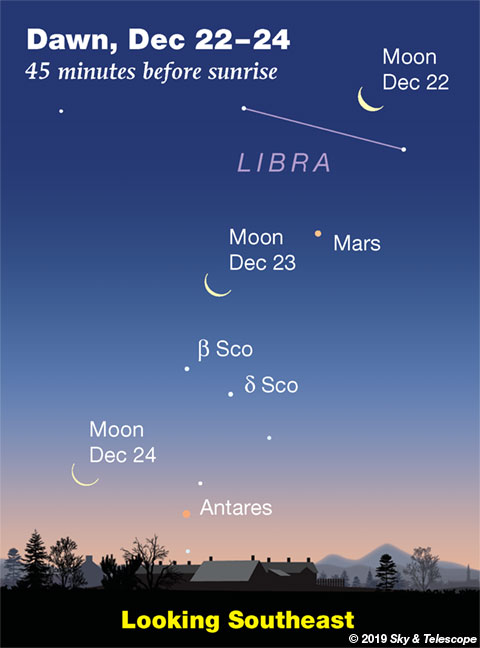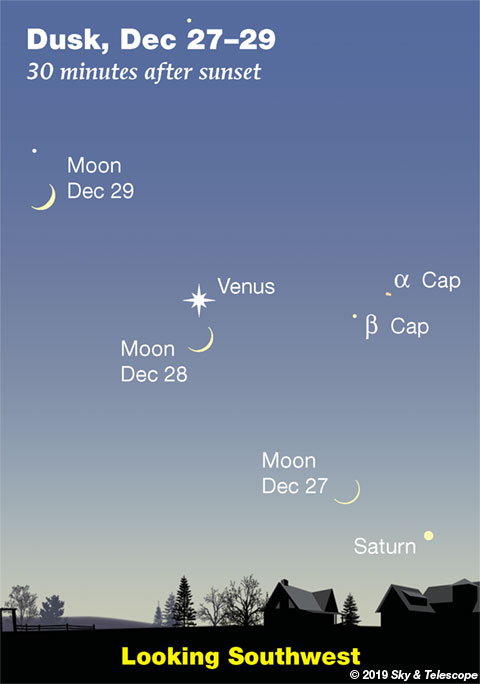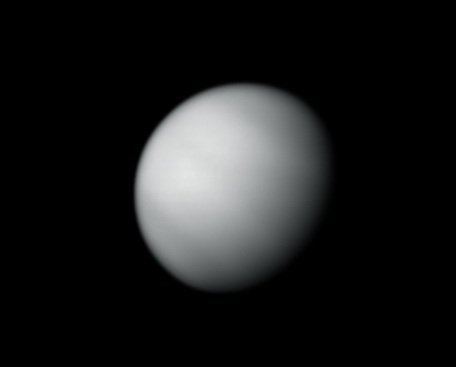Friday, Dec. 20
• As fall turns to winter, Vega, the "Summer Star," still hangs in there in the northwest after dark. How much longer it will stay in view depends on your latitude; the farther north you are, the longer. If you're north of latitude 51° (Calgary, central Ontario and Quebec, London, Berlin), Vega is circumpolar.

Saturday, Dec. 21
• The Christmas season is when M31, the Andromeda Galaxy, passes your zenith shortly after dark (if you live in the mid-northern latitudes). The exact time depends on your longitude. Binoculars will show M31 just off the knee of the Andromeda constellation's stick figure; see the big evening sky chart in the center of Sky & Telescope.
• This is the longest night of the year (in the Northern Hemisphere; the shortest night in the Southern Hemisphere). The solstice occurs at 11:19 p.m. EST (8:19 p.m. PST), marking the start of northern winter, when the Sun begins its six-month return northward in the sky of Earth.
Sunday, Dec. 22
• In early dawn on Monday the 23rd, look southeast for tiny Mars to the right or upper right of the crescent Moon, as shown above.
Mars is faint now at magnitude +1.6, but it's on its way to a very favorable opposition next October — when it will shine 50 times brighter and appear a big 22 arcseconds wide.
Monday, Dec. 23
• The little Pleiades cluster glitters very high in the east-southeast these evenings, over Orion and Aldebaran. How many Pleiads can you count with your unaided eyes? Take your time and keep looking. Most people can count 6. With sharp eyesight, a good dark sky, and a steady gaze, some can make out 8 or 9.
Tuesday, Dec. 24
• Bright Christmas star. Orion shines in the east-southeast after dinnertime. He's well up now, but his three-star Belt is still nearly vertical. The Belt points down to where Sirius, the brightest star of the night, will rise around 7 or 8 p.m. When Sirius is low it often twinkles furiously, perhaps flashing vivid colors — especially in binoculars.
• Algol is at its minimum brightness tonight, magnitude 3.4 instead of its usual 2.1, for a couple hours centered on 12:02 a.m. EST; 9:02 p.m. PST. Algol takes several additional hours to fade and to rebrighten.
Wednesday, Dec. 25
• Know someone who got a telescope? Maybe you? To get them started right, point 'em here: What to See with Your New Telescope, starting with how to set it up, figure it out, and make it work.
• The Winter Hexagon is the biggest and brightest asterism in the sky — at least the biggest one that's commonly recognized. After about 8 or 8:30 p.m., start with bright Sirius low in the southeast. Look left of it by two or three fists at arm's length to find Procyon. From there go upper left to the Pollux and Castor pair, then high up to bright Capella (passing Menkalinan before getting there). Then jog right to orange Aldebaran, lower right to Rigel in Orion's leading foot, and back down lower left to Sirius.
Inside the Hexagon, well off center, shines fire-colored Betelgeuse.
• New Moon (exact at 12:13 a.m. tonight EST; 9:13 p.m. tonight PST). A new lunar month begins. Unlike a calendar month, which averages 30.437 days long, a lunar month (from one new Moon to the next) averages 29.531 days. This means that, on average, you'll see the Moon in any given phase about one day earlier each month by the calendar.
Thursday, Dec. 26
• After dinnertime now, the enormous Andromeda-Pegasus complex runs from near the zenith down toward the western horizon.
Near the zenith, spot Andromeda's high foot: 2nd-magnitude Gamma Andromedae (Almach), slightly orange. Andromeda is standing on her head. About halfway down from the zenith to the west horizon is the Great Square of Pegasus, including Andromeda's head star forming its top corner. The square is balancing on its opposite corner. From the bottom corner run the stars outlining Pegasus's
neck and head, ending at his nose: 2nd-magnitude Enif, due west and also slightly orange.
• Annular eclipse of the Sun today for parts of southern India, Sri Lanka, Indonesia, Malaysia, and the southernmost Philippines. Partial solar eclipse for most of East and South Asia, Indonesia, and some of Australia. Maps and details.

Friday, Dec. 27
• In twilight about 30 minutes after sunset, spot the thin crescent Moon low in the southwest. It's well to the lower right of Venus, as shown here. Using binoculars, look for faint Saturn disappearing toward the horizon a few degrees lower right of the Moon. This is the last we'll see of Saturn in the evening sky until next summer.
• As the stars come out, face north and look high. Cassiopeia is now a flattened M shape canted at about a 45° angle (depending on where you live). Hardly more than an hour later, the M has turned horizontal. Constellations passing near the zenith appear to rotate rapidly with respect to the direction "up."
• Algol tonight is at its minimum brightness for a couple hours centered on 8:51 p.m. EST.
Saturday, Dec. 28
• Sirius and Procyon in balance? Sirius, the Dog Star, sparkles low in the east-southeast after dinnertime. Procyon, the Little Dog Star, shines to Sirius's left by about two fist-widths at arm's length. If you live around latitude 30° (Tijuana, New Orleans, Jacksonville), the two canine stars will be at the same height above your horizon soon after they rise. If you're north of that latitude, Procyon will be higher. If you're south of there, Sirius will be the higher one.
________________________
Want to become a better astronomer? Learn your way around the constellations. They're the key to locating everything fainter and deeper to hunt with binoculars or a telescope.
This is an outdoor nature hobby. For an easy-to-use constellation guide covering the whole evening sky, use the big monthly map in the center of each issue of Sky & Telescope, the essential guide to astronomy.

Once you get a telescope, to put it to good use you'll need a detailed, large-scale sky atlas (set of charts). The basic standard is the Pocket Sky Atlas (in either the original or Jumbo Edition), which shows stars to magnitude 7.6.
Next up is the larger and deeper Sky Atlas 2000.0, plotting stars to magnitude 8.5; nearly three times as many. The next up, once you know your way around, are the even larger Interstellarum atlas (stars to magnitude 9.5) and Uranometria 2000.0 (stars to magnitude 9.75). And read how to use sky charts with a telescope.
You'll also want a good deep-sky guidebook, such as Sue French's Deep-Sky Wonders collection (which includes its own charts), Sky Atlas 2000.0 Companion by Strong and Sinnott, or the bigger Night Sky Observer's Guide by Kepple and Sanner.
Can a computerized telescope replace charts? Not for beginners, I don't think, and not on mounts and tripods that are less than top-quality mechanically (meaning really heavy and expensive). And as Terence Dickinson and Alan Dyer say in their Backyard Astronomer's Guide, "A full appreciation of the universe cannot come without developing the skills to find things in the sky and understanding how the sky works. This knowledge comes only by spending time under the stars with star maps in hand."
This Week's Planet Roundup
Mercury is hidden deep in the glow of dawn.

Venus (magnitude –3.9, crossing Capricornus) shines in the southwest in evening twilight, a little higher each week. It's on its way up to a grand, high "Evening Star" apparition all winter and into the spring. In a telescope it's small (12 or 13 arcseconds in diameter) and gibbous, since it's nearly on the far side of the Sun from us.
Mars (magnitude +1.6, in Libra) is low in the east-southeast in early dawn. It's on the far side of the Sun and is a very tiny 4 arcseconds in apparent diameter.
Though Mars is far and small now, it's on its way to a fine opposition next October. It will attain an apparent diameter of 22 arcseconds then and shine at an impressive magnitude –2.6, which is 50 times brighter than now.
Jupiter is hidden in conjunction with the Sun.
Saturn (magnitude +0.6) is sinking away into the sunset, farther and farther to the lower right of Venus — which outshines it by 60 times. Saturn is 11° from Venus on December 20th but a wide 19° by the 27th. Binoculars help.
Uranus (magnitude 5.7, in southern Aries) and Neptune (magnitude 7.9, in eastern Aquarius) right after dark stand high in the south-southeast and lower in the south-southwest, respectively. Use our finder charts for Uranus and Neptune.
All descriptions that relate to your horizon — including the words up, down, right, and left — are written for the world's mid-northern latitudes. Descriptions that also depend on longitude (mainly Moon positions) are for North America.
Eastern Standard Time (EST) is Universal Time (UT, UTC, GMT, or Z time) minus 5 hours.
![]() Audio sky tour. Out under the evening sky with your earbuds in place, listen to Kelly Beatty's monthly podcast tour of the heavens above. It's free.
Audio sky tour. Out under the evening sky with your earbuds in place, listen to Kelly Beatty's monthly podcast tour of the heavens above. It's free.
 4
4








Comments
misha17
December 23, 2019 at 4:40 pm
There is a current meme on Twitter with folks tweet "then and now" photos of themselves from 2009 and 2019.
The central line of the Dec 26 annular passes over the island of Borneo. Borneo also had an annular eclipse in January 2009, plus an total solar eclipse in March 2016.
You must be logged in to post a comment.
Rod
December 24, 2019 at 3:21 pm
Merry Christmas mary beth and family 🙂 Rod has been out enjoying some stargazing and also solar observing this morning. Some new, unnumbered sunspots (small, less than Earth size) showing up and reported at spaceweather.com and theskylive.com sites. Looking forward to reading some dark sky observations from you in 2020 🙂
You must be logged in to post a comment.
mary beth
December 24, 2019 at 6:15 pm
Merry Christmas Rod & co...hope y’all have a wonderful celebration! Gorgeous weather here! I guess Sirius is our Christmas star? Hope you see Santa and Rudolph when out stargazing !
You must be logged in to post a comment.
Moni Q
December 26, 2019 at 7:08 am
Hello everyone, December 24 around 8pm my son and i saw this light in the sky and got my olympus x40 and took a photo, then went home and got my Sony x50 and took a photo at 9:18pm, in Hammond La. Later i google planets and stars and your site came on. I read about Orio, Algol and Sirius showing up on Dec, 24, so which one did we see in the dark sky? I am new to learning about the stars and planets.
You must be logged in to post a comment.
You must be logged in to post a comment.